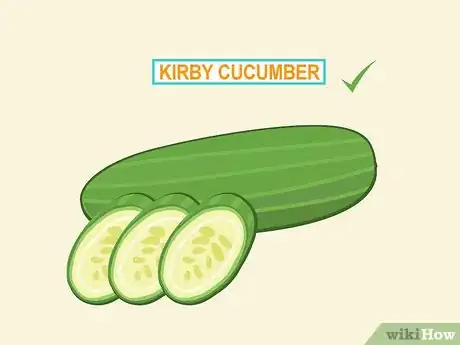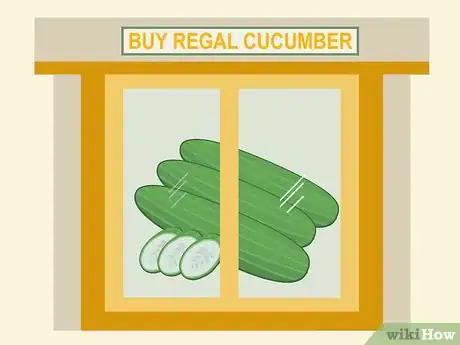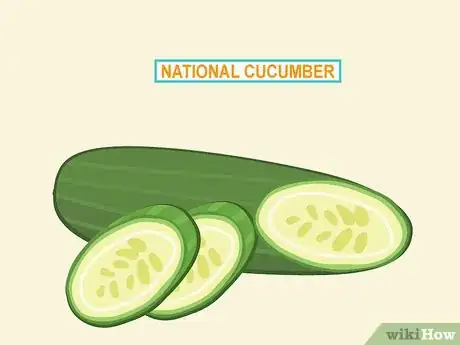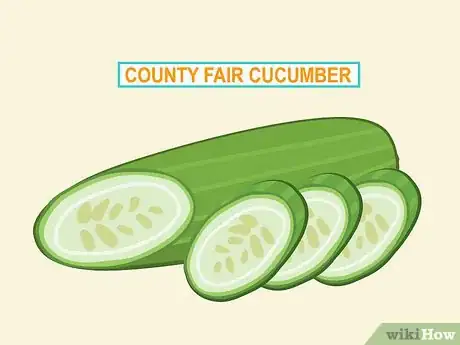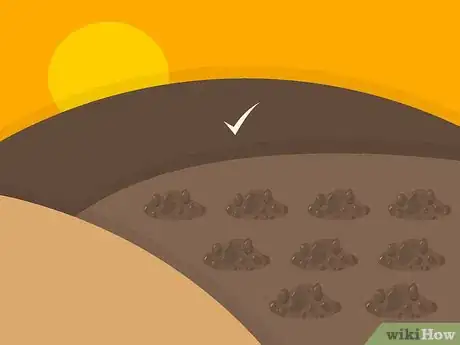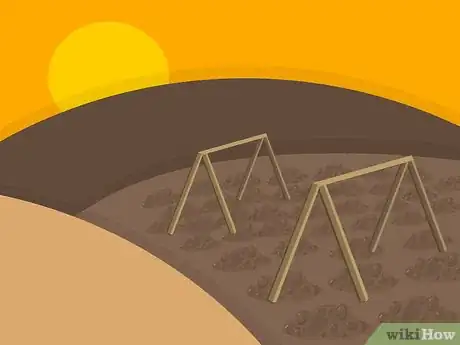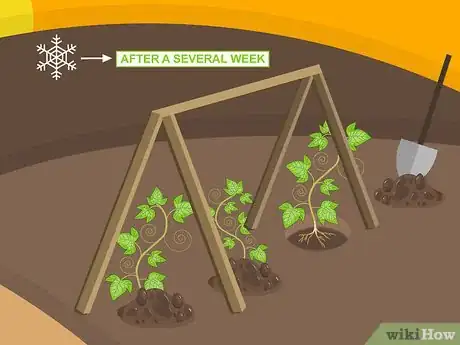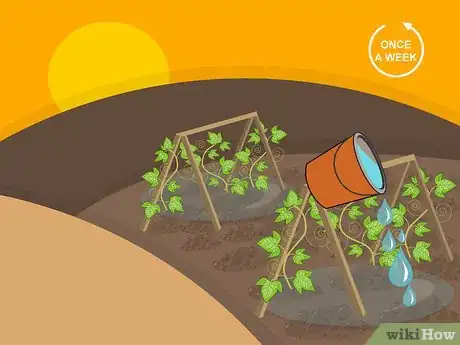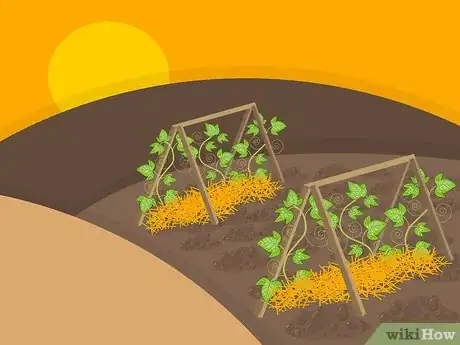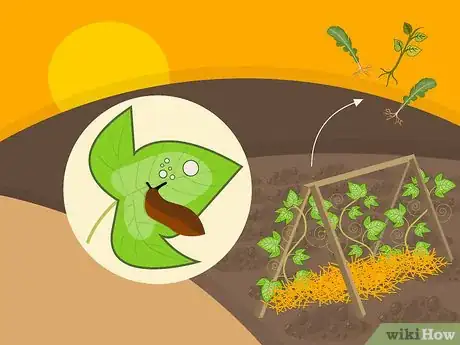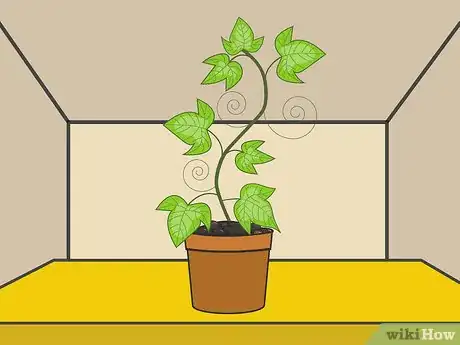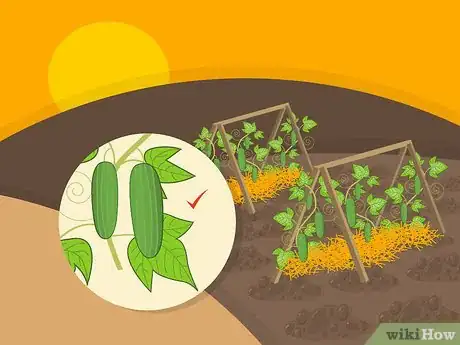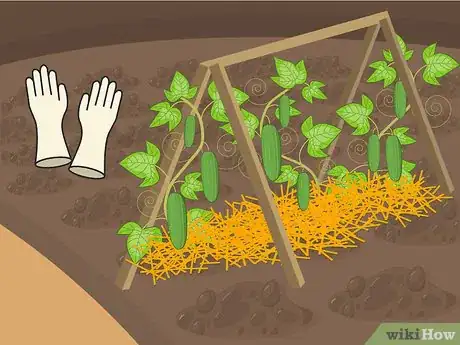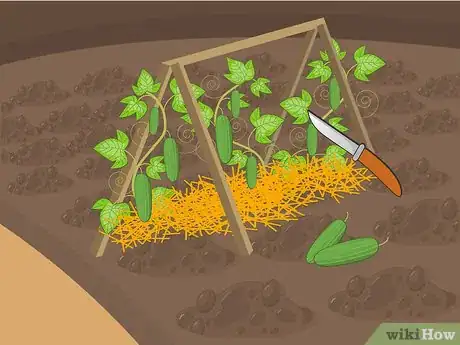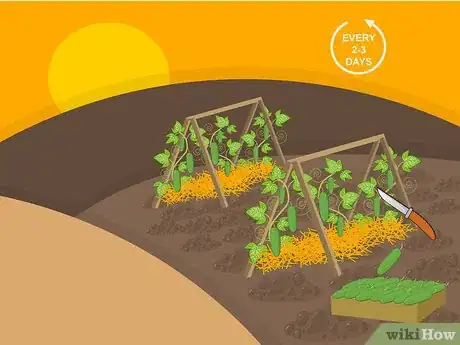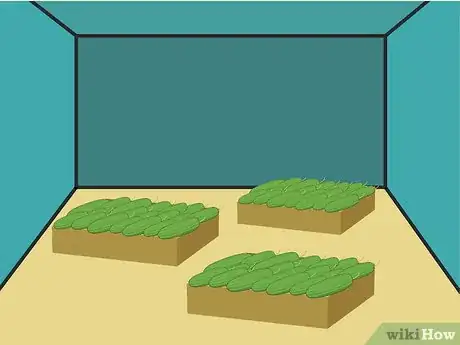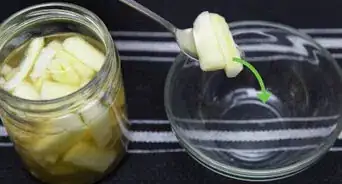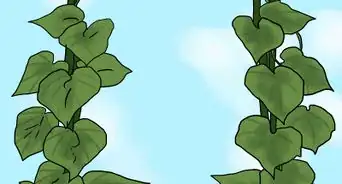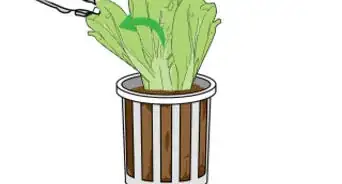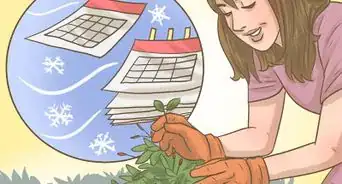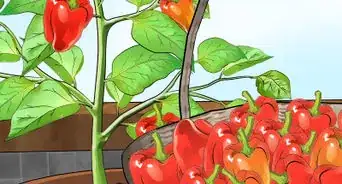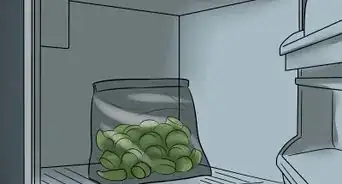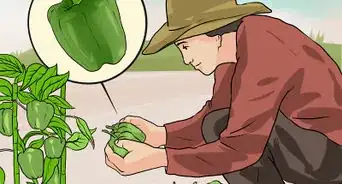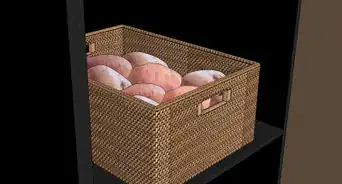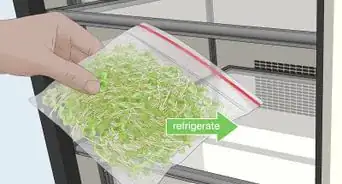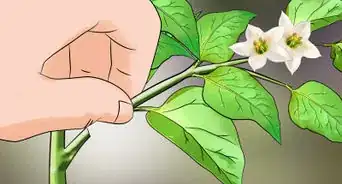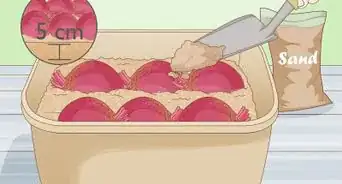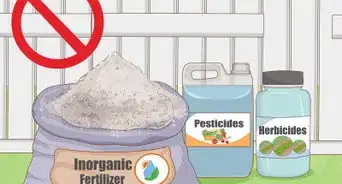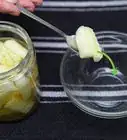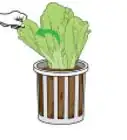This article was co-authored by Lauren Kurtz. Lauren Kurtz is a Naturalist and Horticultural Specialist. Lauren has worked for Aurora, Colorado managing the Water-Wise Garden at Aurora Municipal Center for the Water Conservation Department. She earned a BA in Environmental and Sustainability Studies from Western Michigan University in 2014.
There are 17 references cited in this article, which can be found at the bottom of the page.
This article has been viewed 101,000 times.
If you want to can dill spears this summer but have never grown cucumbers before, you may find yourself in a pickle (pun intended). But growing pickling cucumbers is simple once you know what variety to buy and prepare the right growing conditions. Plant your cucumber variety in the late spring, and take care of your plants as they grow in the coming months. Before you know it, you'll have a bountiful harvest ready to pickle.
Steps
Choosing a Cucumber Variety
-
1Choose Kirby cucumbers for thicker skin. The ideal pickling cucumbers have skin that can withstand the vinegar or salty brine. Kirby cucumbers grow with a thick skin that can remain crunchy after days or weeks in a jar.[1]
- Kirby cucumbers grow to around 6 inches (15 cm) or smaller.
-
2Purchase Regal cucumbers for a disease-resistant crop. Regal cucumbers are less prone to disease than most varieties. Their shape is longer than other cucumber varieties, with a slim seed core. These cucumbers harvest early and produce high yields throughout the season.[2]
- Although Regal cucumbers can grow to 8 inches (20 cm), they pickle best once they reach 3–5 inches (7.6–12.7 cm).
Advertisement -
3Plant National cucumbers for a high yield. This variety is prolific for its large and bountiful harvest. National cucumbers are bulkier than other varieties, with a distinctive dark green skin. Usually, these cucumbers grow to around 5–7 inches (13–18 cm).[3]
-
4Grow County Fair cucumbers for a sweeter taste. County Fair varieties taste milder than other, more bitter varieties. In comparison, these plants make easy-to-digest and almost seedless cucumbers. They grow well in home gardens because of their strong vines.[4]
- County Fair cucumbers pickle best when harvested at around 2 inches (5.1 cm) to 3 inches (7.6 cm).
Planting and Growing Cucumbers
-
1Plant your cucumbers in organic, well-draining soil. Find a sunny spot in your garden with soil rich in organic matter. If your soil has little organic nutrients, add compost to the area before or while you plant. Add a 4–6 inches (10–15 cm) layer of compost to your soil.[5]
- Most cucumber varieties need at least 6 to 8 hours of sun per day. Although cucumbers do well in hot climates with direct sunlight, you may need to water them more frequently.[6]
-
2Install a trellis for your plant. Cucumbers grow best vertically since their vines need a place to climb. Build or purchase a trellis, and plant your cucumbers directly below it. Once vines begin to grow, train your cucumbers to grow on the trellis. If necessary, you can use Velcro straps or twine to secure the vines to the trellis.
- Cucumbers grown on a trellis are easier to harvest because they hang nearer to eye level and are less caked in dirt.[7]
-
3Seed or transplant seedlings several weeks after the last frost date. Most cucumber varieties are sensitive to the cold. Wait at least 2 weeks after the last frost before you plant your cucumbers. Poke seeds into the soil about 2 inches (5.1 cm) deep for seeds or 1 inch (2.5 cm) for seedlings.[8]
- Space plants about 6 inches (15 cm) apart so they have room to grow on the trellis.[9]
-
4Water your cucumber plant at least once a week. Cucumber plants need at least 1–2 inches (2.5–5.1 cm) of water per week to grow. Depending on your climate, you may need to water more frequently than once per week. Stick your finger into the soil to check if it's moist. If the soil is dry, water your plants.
- Sandy soil usually needs more frequent watering.
- Water your plants in the morning or early evening when the sun is low in the sky.
-
5
-
6Watch for pests and weeds. Cucumber beetles, pickle worms, and spider mites are common cucumber pests.[11] Cover your seedlings with netting or spray vegetable-friendly pesticides to keep pests at bay. Check your garden for weeds once or twice a week, and uproot them as they are spotted.[12]
- If you use pesticides, choose a brand certified as non-toxic for vegetable plants.
-
7Grow your cucumbers in pots as an alternative. In cold climates, you can grow potted cucumber plants indoors or in a greenhouse. Fill a large, well-draining pot with soil, and install a trellis for your plant's vines to climb. Place your pot in a place where it can receive direct sunlight daily, and remember to water it once per week.
Harvesting Your Cucumbers
-
1Watch your cucumbers for signs of maturity. Cucumbers usually take between 55-60 days after planting to harvest. Your cucumbers are ready to harvest when they reach the recommended size for their variety. If your cucumbers are yellowing at the bottom, they're overripe and must be harvested immediately.
- Check your plants daily, as much can change over the course of 24 hours.
-
2Wear a thick pair of gardening gloves while you harvest. Do not pick cucumbers with your bare hands. Although some varieties have smooth vines, most are prickly. Find a study pair of work gloves to wear as you work.[13]
-
3Cut your cucumbers off the vine with a sharp knife. Pulling cucumbers off the vine can damage the plant and cut off growth for the other cucumbers. Use a sharp pair of pruners or a knife to snip the vine about 1⁄4–1⁄2 inch (0.64–1.27 cm) above the fruit.[14]
-
4Continue picking every 2-3 days. Not all of your cucumbers will mature at once. If some fruits haven't grown to the ideal length yet, don't pick them until you're ready. Try to pick your cucumbers in groups every several days.[15]
-
5Store your cucumbers at room temperature. Cucumbers do not keep well at anywhere below 50 °F (10 °C), which is when they are vulnerable to frost damage. Store your cucumbers on your kitchen counters or in the front of your refrigerator, where temperatures are warmest.[16]
- Cucumbers last between 1-2 weeks. Plan to pickle your cucumbers before this time.[17]
Expert Q&A
-
QuestionMy cucumbers are growing like a squash, with a long neck and bulb. Is this normal?
 Lauren KurtzLauren Kurtz is a Naturalist and Horticultural Specialist. Lauren has worked for Aurora, Colorado managing the Water-Wise Garden at Aurora Municipal Center for the Water Conservation Department. She earned a BA in Environmental and Sustainability Studies from Western Michigan University in 2014.
Lauren KurtzLauren Kurtz is a Naturalist and Horticultural Specialist. Lauren has worked for Aurora, Colorado managing the Water-Wise Garden at Aurora Municipal Center for the Water Conservation Department. She earned a BA in Environmental and Sustainability Studies from Western Michigan University in 2014.
Professional Gardener Yes, as some varieties of cucumbers don’t have regular shapes. However, consistent/regular watering will help the cucumbers grow into regular shapes.
Yes, as some varieties of cucumbers don’t have regular shapes. However, consistent/regular watering will help the cucumbers grow into regular shapes. -
QuestionShould vines be thrown away after harvesting cucumbers?
 DenisekeCommunity AnswerIf the vines are healthy, you can compost them. If they have any fungus on them, you should get rid of them (do not compost). Cucumbers are annual plants, so there is no point in keeping them in the ground once the growing season / harvesting is over.
DenisekeCommunity AnswerIf the vines are healthy, you can compost them. If they have any fungus on them, you should get rid of them (do not compost). Cucumbers are annual plants, so there is no point in keeping them in the ground once the growing season / harvesting is over. -
QuestionWhat if my cucumber seeds grow yellow cucumbers?
 Community AnswerYellow cucumbers are usually not safe for consumption. They may be over-watered, infected with a virus, or lacking nutrients. Monitor your watering habits and mulch your cucumbers regularly.
Community AnswerYellow cucumbers are usually not safe for consumption. They may be over-watered, infected with a virus, or lacking nutrients. Monitor your watering habits and mulch your cucumbers regularly.
Things You'll Need
- Cucumber seeds or seedlings
- Water
- Watering can
- Trellis
- Netting
- Non-toxic pesticides
- Mulch
- Gardening gloves
- Sharp knife
References
- ↑ http://www.bonappetit.com/test-kitchen/cooking-tips/article/from-the-market-cucumber-pickles
- ↑ http://www.sbcanning.com/2011/06/what-is-best-type-of-cucumber-for.html
- ↑ http://www.backyard-vegetable-gardening.com/cucumber-varieties.html
- ↑ https://www.harvesttotable.com/_here_are_20/
- ↑ http://www.the-compost-gardener.com/can-you-plant-a-vegetable-garden-in-pure-compost.html
- ↑ http://www.vegetablegardeninglife.com/growing-cucumbers.html
- ↑ http://anoregoncottage.com/five-reasons-to-grow-cucumbers-on-trellis/
- ↑ https://www.almanac.com/plant/cucumbers
- ↑ https://www.mnn.com/your-home/organic-farming-gardening/stories/21-tips-for-growing-cucumbers
- ↑ https://www.almanac.com/plant/cucumbers
- ↑ http://www.clemson.edu/extension/hgic/pests/plant_pests/veg_fruit/hgic2207.html
- ↑ http://www.gardeningpatch.com/vegetable/growing-cucumbers/
- ↑ https://www.veggiegardener.com/threads/how-and-when-to-pick-cucumbers.1677/
- ↑ http://savvygardening.com/how-to-plant-cucumber-seeds/
- ↑ http://veggieharvest.com/vegetables/cucumber.html
- ↑ http://www.thekitchn.com/the-best-place-for-storing-cucumbers-173142
- ↑ https://www.eatbydate.com/vegetables/fresh-vegetables/how-long-do-cucumbers-last-shelf-life-expiration-date/
- ↑ http://www.mykitchengarden.info/2014/05/growing-cucumbers.html
